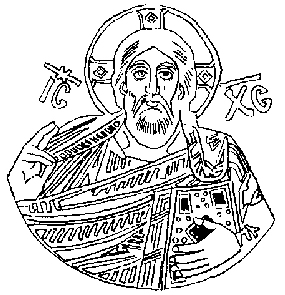

Christianity arrived in Russia from the Byzantine Empire. The princes imposed it on the population in 986, then disseminated through the land. Church services consisted of Bible readings, hymns, prayers, and sermons. The services featured great pageantry, rich costumes, and hours of choral singing.(1) Unlike in the Latin Church, all the rituals were conducted in church Slavonic, similar enough to Russian to be understandable to the worshippers. Princes imported artists and architects to fill the cities with churches and icons. Monasteries and nunneries were founded and become centers of learning. Most important of these was the Monastery of the Caves at Kiev, where the Primary Chronicle was written. Significant monasteries thrived in Novgorod as well.
One of the great gifts of Christianity to Russia was a written language. St. Cyril, a 9th century Christian missionary to the Bulgarians created an alphabet, Cyrillic, for the Slavic languages. Unlike in Western Europe, the Bible and church literature were accessible to the Rus' in Church Slavonic. The Bible, for example, circulatedin sections, with emphasis on books in the Old Testament. The monasteries also began to transcribe native Russian writing.
The Church had its own courts and laws, which applied to all. It regulated crimes against the church and church hierarchy, family conflict, sexuality, duty to parents, and slander. The Orthodox church was hostile to sexuality, which it saw as a necessary evil, valuing celibacy as a high virtue. This view supported the ancient social conservatism-Slavic peoples traditionally saw marriage and sexuality as the community's business. Church law defined marriage as a central element in social structure. It proscribed promiscuity, adultery, divorce, and homosexuality.(2) The Church codified charity as a duty, supported hospitals, and objected to slavery.(3) Otherwise indigent individuals, those outside the social support network, were given shelter in the monasteries. On the other hand, the church did not oppose warfare or executions, or take action to suppress the slave trade.
Christianity can be seen as a civilizing influence on the Rus'. It was brought in by the princes to unify the state and connect it with the wealthier culture to the south. The first Russian saints were murdered princes, Boris and Gleb. A pantheon of other noble saints followed, eventually including Prince Alexander Nevski. The Rus' were careful to keep a certain distance from Byzantine Church authority, asserting early the independence of their church.
In Novgorod the Church wielded great power. Its citizens would have universally described themselves as Christian. Yet the old religion rested, consciously or not, beneath a Christianized surface: When Prince Vladimir built his first church it was over a pagan temple.(4) When Christian saints were venerated they absorbed the older deities-Elijah superseding Perun and St. Vlas, Veles.(5) Paganism was also preserved in folk knowledge. It is striking how much remained when folk tales were transcribed more than half a millennium later. Notable also, are several passages in The Primary Chronicle where magicians appear in Christianized Russia-they wreak havoc, deceive the common people and are eventually slaughtered by righteous Christian princes. Are these descriptions of Pagan revival? All that remains is one side of the story.(6)
(1) Lecture "Byzantine and Russian Music" by Nicolas Schidlovsky,
Metropolitan Museum, May 28, 1997.
(2) Levin, pp. 76-84.
(3) Vernadsky, Kievan Russia, p. 265.
(4) Hamilton, p. 22.
(5) Vernadsky, Kievan Russia, p. 264.
(6) Cross, pp. 150-154 (1071).